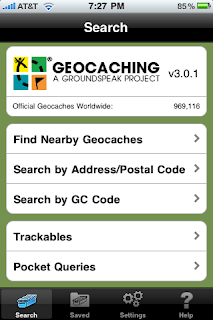Ever since I was a kid, electronic fun and real fun have been distinct in my mind. Computers, and video games, were something that pulled us away from the rest of our lives. They didn't interact with the rest of the world in any satisfying way, and so time in the electronic world was "stolen" from real life.
More recently, computers could at least chronicle other parts of life in a more vibrant way. As processing speed and storage capacity have increased, we have moved from using computers to store and manage words and numbers to bringing home sounds, pictures, and video clips and stashing them in our digital nests. This is the "digital hub" concept that has served Apple so well in recent years. Notice, though, that in this model we still go out into the real world, capture it with minds and cameras and recorders, and bring it back to the computer, like a crow would collect bits of ribbon and thread.
Now, the iPhone has taken that processing power and digital capacity and shrunk it to such a small size that we can take it out into the world *with* us. The computer has shrunk to the point where we can carry it in our pockets, so we can now mix and match computing and real life the way most of us already mix and and match printed text and pictures into our lives. The best applications, in fact, are those that have surpassed the role of "paper analog" and are really adding features that dead tree resources can't match. This is only fair, given the expense and complication of buying and charging and learning to use an electronic gadget. If it is higher maintenance than a book (which it certainly is) we should get something back for our troubles!
Perhaps the most obvious way that at iPhone can mix computing with the real world is in navigation. The "maps" program that Apple built for the iPhone is really pretty awesome, for instance. You can search for things on it, and zoom in and out, and switch from "map" view to "satellite image" or a combination of the two. Those of us carrying the iPhone 3GS even have a compass to go with our maps, which (to those of us who are old-school navigators) is really mind-boggling.
There are apps that have gone beyond this one, of course. There is the whole category of dashboard turn-by-turn direction applications. I'm not going there in this posting, however. Those aren't about play, they are about work.
Motion-X GPS uses the same basic technology as the Maps app, but adds cool things like bearings, and speed, and waypoints that you can place on the map like digital pins (or digital breadcrumbs that the birds can't eat).
I would also mention Accuterra, which I downloaded last summer and have been pretty pleased by. We were camping in Vermont, where we don't always get a good connection. So, I needed something that would load all the requisite maps onto the phone itself, rather than just pulling the required tiles across the 3G connection like the Maps app does. Accuterra does just that. You are still relying on the signal from the GPS satellites, which can be a bit dicey in the woods and valleys of Vermont, as well as the natural magnetic waves that the compass relies upon, but those are more reliable in the wilds of Vermont than line-of-sight to an AT&T tower.
Third in the category of navigation, I would include the Geocaching application. Geocaching is an activity that uses the accuracy of GPS navigation to allow folks to hide little containers in the woods. The person who creates the cache then posts coordinates and other info about their cache online, and the rest of us can look up that information, go out hunting the cache, and celebrate when we find it by exchanging little trinkets and signing logbooks. A rather simple game of hide-and-seek when you get right down to it, but I have been amazed at how many hikes we have taken our boys on where we didn't hear even one bit of complaining because the thrill of the hunt so thoroughly drowned out the "how much longer" refrain in their experience (and, therefore, in ours as well). One can use any GPS device to do this, but having the dedicated app on a phone integrates the multiple steps of researching, selecting, navigating to, and logging the cache.
Outside of the category of navigation, there are many apps that serve to educate us in skills that seem far from the realm of space invaders and Facebook. "Knots and Splices" is a "port" of an honest-to-goodness book about tying knots and splicing ropes. The creators went out of their way to maintain the look of the original book, and that adds to the pleasure of using it (in my experience).
iBird, on the other hand, was created by someone who shares my frustration with traditional birding field guides. "If I don't know how to spell it, how can I look it up in the dictionary" I have heard people say about words, and I feel the same way when faced with even the glossiest and well-researched paper field guides. Instead, this app serves as a multimedia database, which you can query using such variables as your location, the type of terrain you found the bird in, and (of course) the size, shape, and color of the bird you are watching. Once you have a suspect identified, you can play its call or song and see if it matches. Awesome!
iBird, on the other hand, was created by someone who shares my frustration with traditional birding field guides. "If I don't know how to spell it, how can I look it up in the dictionary" I have heard people say about words, and I feel the same way when faced with even the glossiest and well-researched paper field guides. Instead, this app serves as a multimedia database, which you can query using such variables as your location, the type of terrain you found the bird in, and (of course) the size, shape, and color of the bird you are watching. Once you have a suspect identified, you can play its call or song and see if it matches. Awesome!
I'm sure there are many more things we can add to this -- I hope to post more as we go. In the mean time, I hope this list dispels the myth that there must be a barrier between electrons and "real life".
BTW -- if anyone suggests a way for your iPhone to help you start a fire, say "no" :-)















